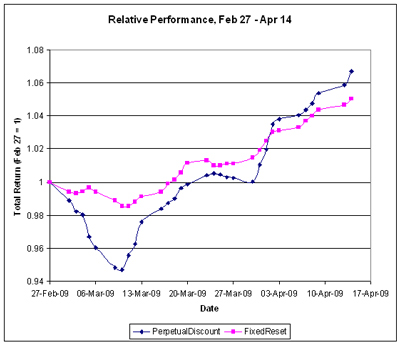The April, 2009, edition of PrefLetter has been released and is now available for purchase as the “Previous edition”. Those who subscribe for a full year receive the “Previous edition” as a bonus.
As previously announced, PrefLetter is now available to residents of British Columbia and Manitoba, as well as Ontario and to entities registered with the Quebec Securities Commission.
Until further notice, the “Previous Edition” will refer to the April, 2009, issue, while the “Next Edition” will be the May, 2009, issue, scheduled to be prepared as of the close May 8 and eMailed to subscribers prior to market-opening on May 11. It will make an admirable Mother’s day present!
PrefLetter is intended for long term investors seeking issues to buy-and-hold. At least one recommendation from each of the major preferred share sectors is included and discussed.
Note: A new enhancement to the PrefLetter website is the Subscriber Download Feature. If you have not received your copy, try it!
Note: Some subscribers will have received two copies of this month’s edition; others will have received their copy as a direct eMail from me. I apologize for this; I experienced a most inopportune software failure.
Note: PrefLetter, being delivered to clients as a large attachment by eMail, sometimes runs afoul of spam filters. If you have not received your copy within fifteen minutes of a release notice such as this one, please double check your (company’s) spam filtering policy and your spam repository. If it’s not there, contact me and I’ll get you your copy … somehow!
Note: There have been scattered complaints regarding inability to open PrefLetter in Acrobat Reader, despite my practice of including myself on the subscription list and immediately checking the copy received. I have had the occasional difficulty reading US Government documents, which I was able to resolve by downloading and installing the latest version of Adobe Reader. Also, note that so far, all complaints have been from users of Yahoo Mail. Try saving it to disk first, before attempting to open it.
